Customer service burnout is endemic. And it’s costing your company money. The good news is, if you spot it early, there are easy and actionable steps you can take to mitigate its effects and improve employee retention.
Customer service burnout refers to a state of physical, emotional, and mental exhaustion that customer service representatives may experience due to prolonged stress or overwork. This condition can be exacerbated by the repetitive nature of the job, dealing with difficult or irate customers, and the pressure to maintain high levels of service quality. Burnout can lead to decreased productivity, lower job satisfaction, increased absenteeism, and even health problems.
Customer service is a demanding and stressful job, especially in the era of digital transformation and rising customer expectations:
- Customer service agents are often the first point of contact for customers who have questions, complaints, or issues with a product or service.
- They must deal with angry, frustrated, or impatient customers and complex problems requiring quick and effective solutions.
- They must also cope with high workloads, low pay, and limited autonomy.
All these factors can lead to customer service burnout.
In this article, we will explore the causes and symptoms of customer service burnout and the best practices and strategies to prevent and overcome it. We will also share some success stories and tips from customer service experts and leaders who have successfully managed burnout in their teams. By the end of this article, you will better understand how to create a healthy and productive customer service culture that benefits both your employees and customers.
What makes customer service agents burn out
“It’s a very emotionally demanding job,” says Ty Schalamon, who spent years as a customer service manager at SketchUp before transitioning into sales.
Jeff Toister of Toister Performance Solutions and author of The Service Culture Handbook released a 2023 survey of customer service agents that reveals that 59% of customer service reps are at risk of burnout, including 28% who are at risk of severe burnout.
“One of the things that happens in customer service is we’re engaging a part of our brain that focuses and refocuses attention, and it consumes a lot of energy. That’s why at the end of the day serving customers, you might not have done a lot of physical work, but you physically feel exhausted,” Toister explains.
The costs of customer support burnout
That level of emotional demand and customer service burnout means high turnover rates in customer service.
“Most people can’t do it for very long. Two years is about the max,” Schalamon adds.
And that turnover is expensive.
Gallup estimates that replacing a single employee costs one-half to two times the employee’s annual salary, and that’s conservative. Gallup offers an example of a 100-person company with an average salary of $50,000 per year and estimates that this hypothetical company would burn between $660,000 and $2.6 million per year on turnover. That’s based on a 26.3% annual turnover rate.
There’s not only a direct financial cost. There are lost opportunity costs as well.
“If you have an opening and have not been actively recruiting, it generally takes a couple of weeks or more just to fill the opening. So let’s generously call it four weeks between the opening and having a person walking in the door on day one. That’s a month of misery,” Toister says.
And Toister says that’s an optimistic estimate. In reality, it’s more like 3-4 months of longer support queues and unhappy customers—one month to hire the right candidate and up to 3 months to train them.
“That’s a lot of pain. It’s the cost not only of having to hire and train that person, but it’s the cost of less productivity, missed sales, poor customer service, and having other people have to cover all those shifts and pay overtime. So it can be exceptionally costly,” Toister adds.
Preventing customer service burnout should be a top priority for your company in order to maintain good customer service.
Let’s talk about how you can spot burnout in your team and how to fix it.
How to spot customer service burnout
“Burnout. This one word is so powerful, and yet it hardly captures the deep emotional and spiritual costs of losing one’s inner flame. Burnout is serious and hard to repair. Waking up without a taste for the day ahead destroys joy. We can get used to living that way—and many people do—but it leads to life as a form of despair rather than an embrace of the richness around us. Many of us aren’t savoring our lives. We may have more than enough in the way of belongings and interesting activities, yet we have a pervasive sense of emptiness, a vague dissatisfaction. Burnout diminishes our ability to savor our quality of work and our relationships. People who are chronically tired lose their gusto. At that point, life tastes like dust because we’ve become too exhausted to relish it.”
Dr. Marilyn Paul, An Oasis in Time
“Burnout is a physical or mental exhaustion, and there are three specific characteristics,” Toister says.
Those three changes to look for are:
- Bad attitude
- Demotivation
- Reduction in performance
Other changes to look for include:
- Increased absenteeism
- Increased sensitivity to feedback
- Physical symptoms like headaches and nausea
Oftentimes, burnout can sneak up on us before we realize what’s happening. According to Emily Nagoski and Amelia Nagoski, authors of Burnout: The Secret to Unlocking the Stress Cycle, here are three symptoms identified by Herbert Freudenberger in 1975:
- Decreased sense of accomplishment: An unconquerable sense of futility and feeling that nothing you do makes any difference.
- Depersonalization: The depletion of empathy, caring, and compassion.
- Emotional exhaustion: The fatigue that comes from caring too much for too long.
It’s your and your organization’s responsibility to identify the causes and how to treat and/or prevent them because it’s affecting their health and your bottom line.
Let’s explore some ways you can avoid burnout in your organization.
How to prevent customer service burnout on your team
Now that we’ve established how to spot burnout and why it’s your responsibility to prevent it, how can you do that? There are many ways—some easier than others—but all are important to keep in your turnover-reduction toolbox.
Start at the top
“One of the items identified in the report correlated to burnout or burnout resilience was a feeling that your company generally has good products and services,” Toister says.
It’s pretty simple: if your company sells high-quality products, you will have fewer disgruntled customers, which in turn reduces stress on your customer service team.
“They’re not calling angry. They’re calling with maybe a question or [because] they’re delighted,” Toister says.
As Amazon’s leadership principles have proven: the best customer service is no service. If your company sells good products and is proactive with customer communication, that means lighter loads and less stress for customer service.
Make your company customer-oriented
“Most organizations have not clearly defined what a great customer experience looks like. Ask your employees: ‘What does a great customer experience look like,’ and you’ll get a lot of great answers. They’ll just all be different,” Toister says.
“I think this is where a lot of people end up smacking their forehead when they realize this,” Toister adds.
Toister instructs companies to develop one simple statement to drive the customer experience, whether they call it a vision statement, mission statement, or a brand promise. Whatever you call it, it has to be simple and offer clarity.
Next, companies must share it with their employees and ensure they understand what it means and how to implement it.
How can you test that? Again, ask your employees what a great customer experience looks like. “If you don’t get a consistent answer, you haven’t done your job as a leader because we need everybody on the same page,” Toister says.
Finally, you must ensure that your decisions align with the customer experience statement.
“If I’m making decisions that are aligned with our definition of a great customer experience, it’s really easy for employees to do great work. But if I’m making decisions that are not aligned, or as a leader, I’m not modeling what a great experience should look like, then I create conflicts for employees,” Toister says.
Toister illustrates this principle by comparing a misaligned company to a car with misaligned wheels. When there’s no clear alignment, your organization swerves all over the road, struggling to stay in its lane.
A classic example of this misalignment is survey begging, which you’ve probably experienced. It seems like we’re presented with a survey at the end of every customer service interaction, with the agent often requesting a high score.
“Once I give them an employee a goal to achieve a certain score on a survey, then they don’t care about doing better. They just want a good score on the survey,” Toister says.
Offer more feedback and support
A low-cost way customer service managers can reduce burnout is to be more involved with their team members. The vast majority of agents who are at low risk of burnout report that they receive regular feedback from their bosses.
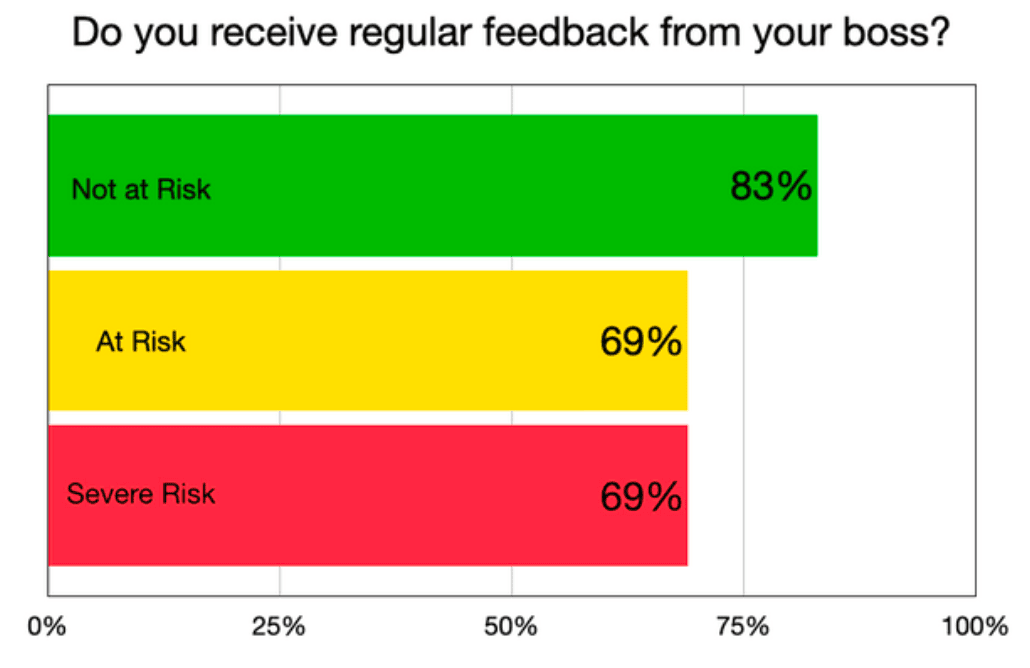
Likewise, there is a strong correlation between burnout risk and having a supportive boss. “94% of low-risk agents have a supportive boss, compared to just 77% of high-risk agents,” the report says.
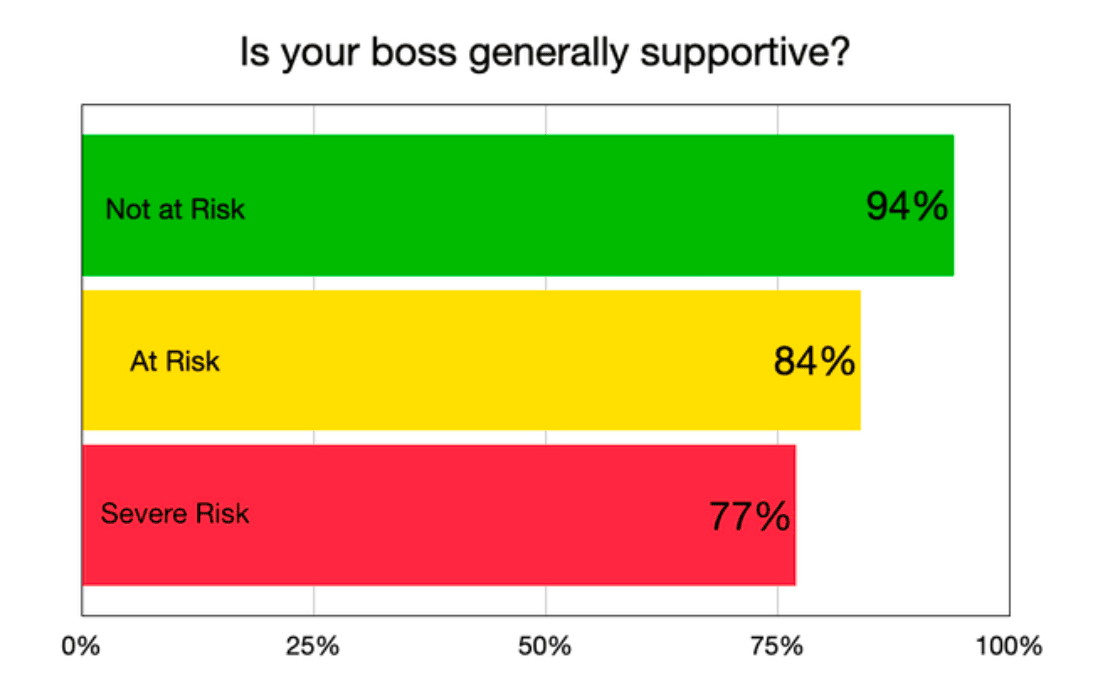
“On one end, you have agents who don’t feel they get regular feedback. They don’t get a lot of support from their boss. There was even an article in the Wall Street Journal just last week about how companies are increasingly using AI to supervise contact center agents, which is horribly dehumanizing,” Toister says.
“On the other hand, many agents say my boss is really supportive, and that tied directly to burnout resilience. If I feel like my boss has got my back, I’m much more likely to be resilient to burnout,” Toister continues.
One way to support your team is to ensure they have ample breaks and self-care opportunities. Do they have time to go for walks, practice mindfulness, or exercise?
Empower your agents
Maybe your company sells great products and is zeroed in on a great customer experience, but do you give your customer service reps the tools and authority to please customers?
Toister found a high correlation between disempowered agents and burnout. “In many cases, contact center agents are not fully empowered to do what’s right for the customer. And that can be extremely frustrating,” he says.
How do you empower your customer service team?
“It starts by defining empowerment. When I’ve looked at customer-focused organizations, they define empowerment as enabling employees to do good work,” Toister says.
He outlines three ways companies can empower customer service:
- Give them enough resources: Ensure your teams have the software and other tools needed to do the job. For instance, can an agent quickly approve a return, offer a refund, or ship out a replacement?
- Implement best practices for resolving issues: Have well-ordered policies and procedures in place to handle most customer complaints.
- Hand over authority: Give agents the authority to bend the rules or quickly resolve a problem if no procedure is in place.
“We think of empowerment as letting agents do whatever they want, but that’s not really it. It’s best-practice procedures so that I can consistently serve my customers at a high level,” Toister says.
He offers the example of a situation where one agent may take five minutes to resolve an issue while another might take 30 minutes. “No one wants to be that 30-minute customer or that 30-minute agent, so we need best practices,” Toister says.
“I imagine a tool like TextExpander makes it easier to access templates really quickly. Those things make the agent’s job much easier,” Toister says.
Spend more
Many articles say that high pay isn’t tied to happier employees, but Toister hasn’t found that to be true. In his survey, 41% of customer service agents said they don’t feel they are paid fairly. “Agents who feel they are paid fairly are more resilient to burnout,” the report says.
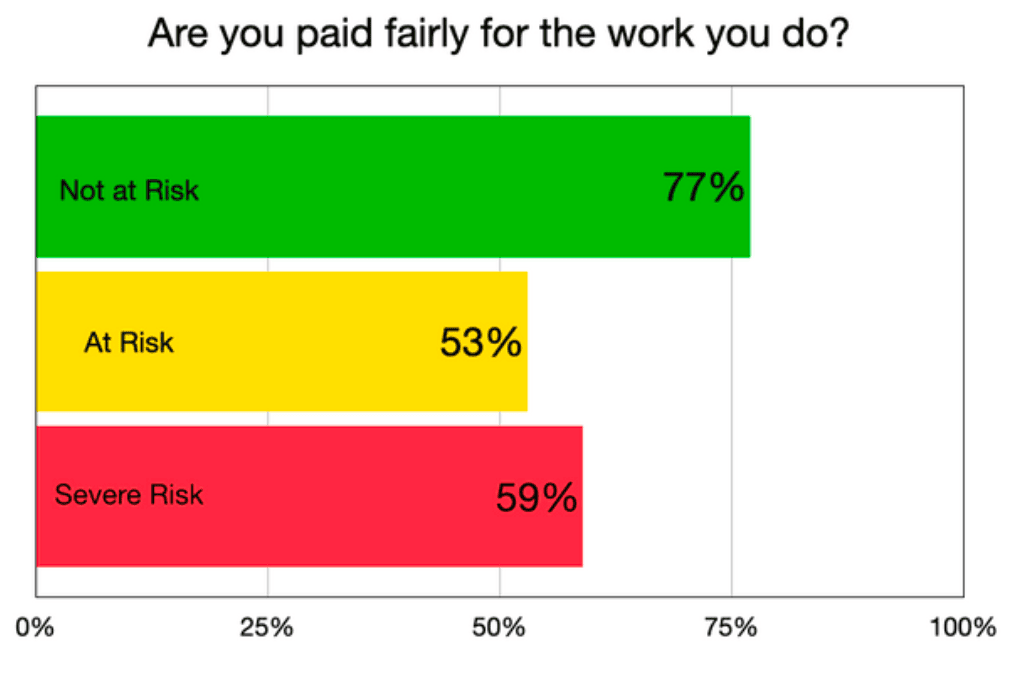
“The research is pretty clear that pay is fundamentally important. You have to pay employees well enough that they’re not thinking about pay, and for most customer-focused organizations, that is paying above the midpoint, but it also allows them to access better talent. It allows them to expect more from their employees and helps them keep their employees longer,” Toister explains.
What compounds the problem is when leaders offer financial incentives to offset low pay.
“If we look at all the research on motivation, we find that providing incentives as an extrinsic motivator—an external motivator—generally hurts performance more than it helps performance. And so, based on this very clear research, I don’t advocate for incentives,” Toister says.
To illustrate the point, Toister gave an example of a company offering $100 bonuses for high customer service survey scores. The result was that Tier 1 support regularly received bonuses, and Tier 2 never did. The reason was that as soon as the customer expressed frustration, the Tier 1 agents escalated them to Tier 2. Tier 2 agents ended up with all the dissatisfied customers, who gave low scores.
“That’s all an example of using surveys as a cudgel instead of helping us do better. We’ve created these horrible incentives,” Toister says.
“I draw a clear line between incentive pay—which does not work in customer service—and just paying employees really well, which is highly effective and is ultimately more efficient because you’re not dealing with lower productivity, lower turnover, chronic absenteeism, etc.,” Toister explains.
Likewise, customer service agents are at much less risk of burnout if the contact center is adequately staffed. Having enough employees and paying them well may cost more up front, but your organization may save money in the long run thanks to reduced turnover.
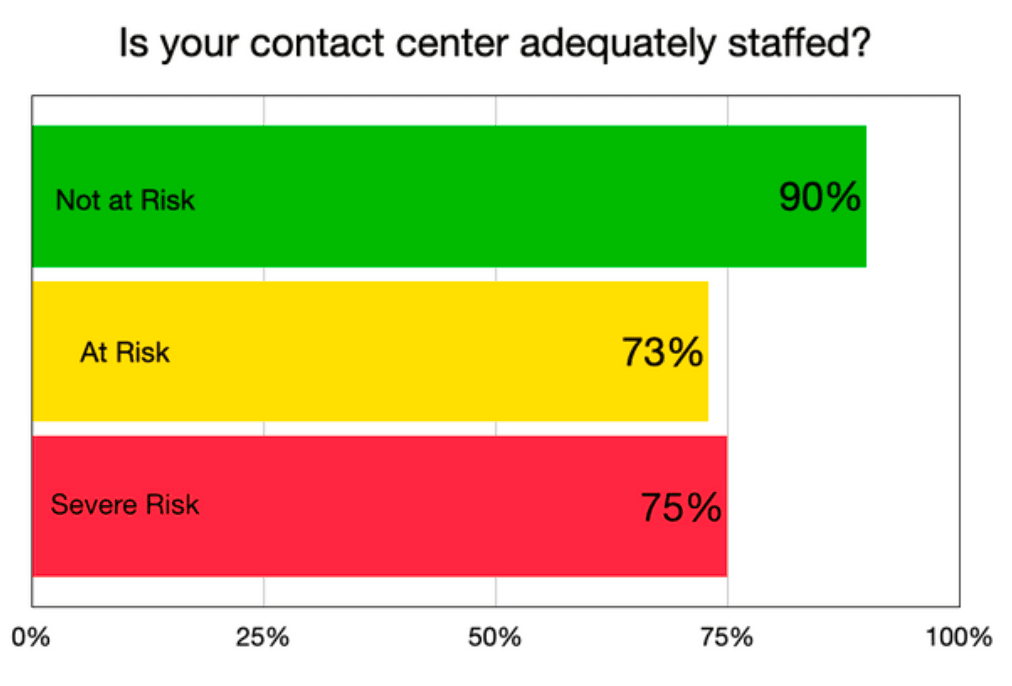
Foster a positive work environment
Employees are at far less burnout risk if their boss sets a positive example. Fostering positivity in your organization is of key importance.
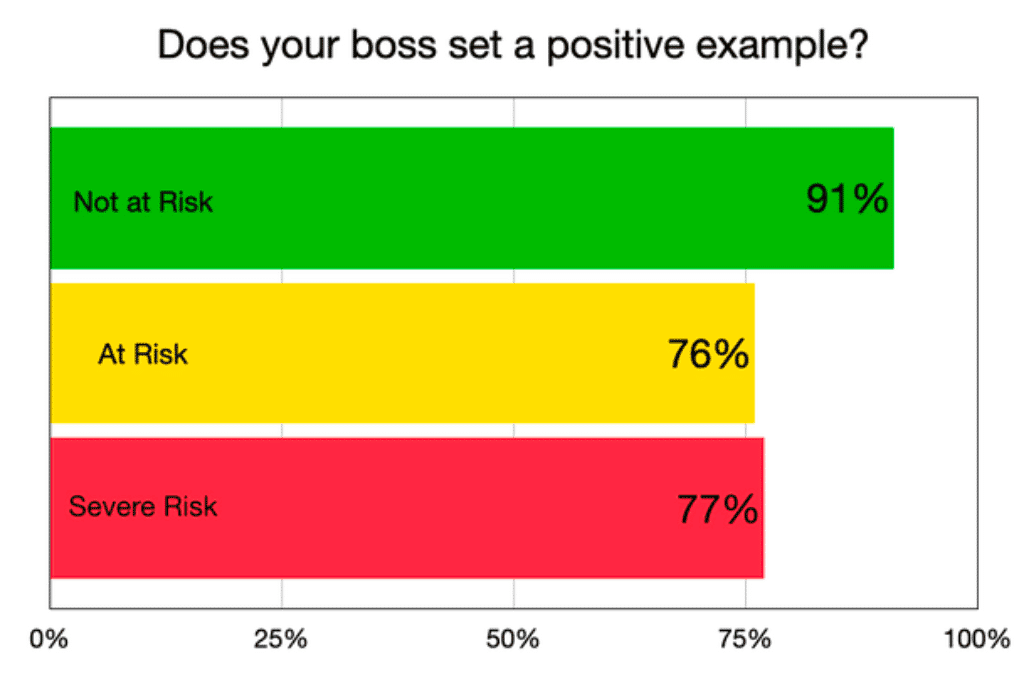
Customer service reps are also far less likely to burn out if they have one good friend at work. Interestingly, while Toister didn’t find a correlation between working from home and burnout risk, he did find that remote employees tended to get more feedback from their boss and develop more friendships at work. “That blew my mind because I did not expect that,” Toister says.
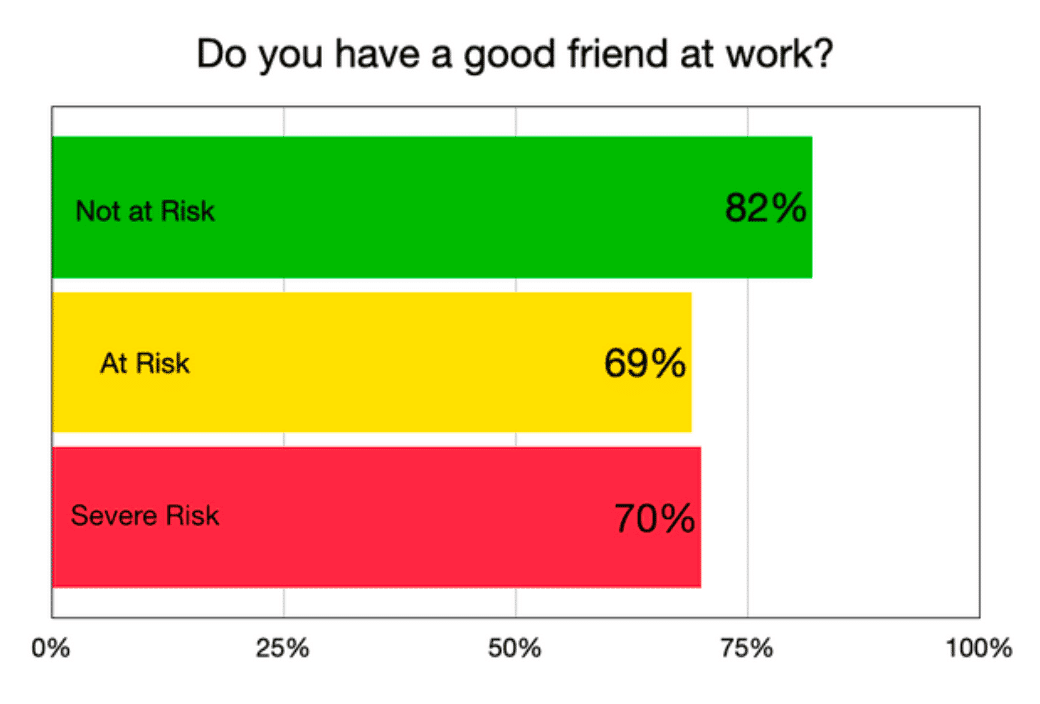
Humor can help foster morale and let your team blow off steam. If you’re feeling frustrated, have a laugh at some customer service memes.
A major impediment to a positive work environment is a toxic employee. It may be cliche, but it’s true: one bad apple spoils the bunch.
“In a separate study that I did, 83% of customer service employees have at least one toxic co-worker, and this is defined as somebody who basically makes the workplace worse. They’re dishonest, they intentionally provide poor customer service, they harass other people, and they just make the environment a bad environment,” Toister says.
Toxic employees spread negativity, which increases the burnout risk for others and drives away talented people who don’t want to work in a toxic environment.
“Another factor that I found in the study is that resilient employees are more likely to trust that their co-workers are doing a great job. And as the burnout risk increases, they’re less likely to feel they can trust their co-workers to provide great customer service,” Toister explains.
Unfortunately, the best solution is to prune the toxic employee.
“There are employment laws that you have to follow, but the short end of it is if you have a toxic employee who’s chronically abusing your culture, abusing policies being dishonest, bullying people, harassing people, the fastest way to handle the issue, the best way to handle issues to fire them because they undermine the rest of your culture,” Toister says.
“What managers tell me is when they finally fire that toxic employee, it’s like a breath of fresh air. Everybody else is like, oh, I can go back to doing a good job again. Because this person is now gone,” Toister continues.
Of course, no manager wants to fire people, so it’s important to focus on creating a positive work environment. Any good gardener knows that many plants must be pruned to grow to their full potential. But pruning doesn’t replace the need to water and nourish the plant—it’s merely one item in the toolbox.
Dealing with customer service burnout
“I think for customer service reps, it’s about finding what works for you and building habits around that,” Toister says.
Toister says the real burnout risk for customer service workers is directed attention fatigue, which is mental fatigue caused by trying to concentrate on a task while blocking out other distractions. The ideal solution is strict uni-tasking, but that isn’t always possible in customer service.
“There’s two parts of our brain that we involve in customer service. One is focusing attention and the other is really blocking out distractions. But customer service is inherently full of distractions,” Toister says.
“Contact center agents are using maybe seven different pieces of software [simultaneously]. We have two, maybe three, monitors on our desks. So we’ve got distractions galore,” Toister explains.
“And that just wipes out that part of our brain. It really makes it tired,” Toister says.
The key for perpetually distracted customer service reps is to find alternative ways to relax their brains.
The symptoms are very similar to ADHD symptoms. Mechanically they’re different in our brain, but the impact is the same. You have less of an ability to focus,” Toister says.
“[It makes it] harder to stop to complete activities. It’s harder to control your emotions. All of these things are really important for customer service reps. We have these habits that are giving us ADHD-like symptoms and burning us out, and there are enough of us who have ADHD already. We don’t need to make it worse,” Toister says.
“Whatever you can do, whether it’s mindfulness exercises, whether it’s simply developing more healthy habits, whether it’s going outside and reading a book on your breaks instead of getting on your phone and checking social media. Any of those things can help clear your mind and restore a little bit of your attention,” Toister says.
Get more sleep
“You need to rest, and there are a few ways to do that. One is to get a good night’s sleep. We know people chronically don’t get enough sleep. So there’s no way around it. You have to find a way to get more sleep,” Toister says.

The benefits of sleep are well-documented. Why We Sleep by Dr. Matthew Walker outlines several eye-opening facts about sleep:
- Regularly sleeping fewer than six hours per night wrecks your immune system and more than doubles your cancer risk.
- Being sleep-deprived causes you to eat more because it increases hormones that make you hungry and suppresses hormones that make you feel full.
- The physical and mental impairments caused by one night of bad sleep dwarf those caused by an equivalent lack of food or exercise.
- Scientists have studied sleep-deprived airplane cabin crews and found that parts of their brains related to learning and memory had physically shrunk, and their short-term memory was significantly impaired.
- Adults who are 45 years or older who sleep fewer than 6 hours per night are 200 percent more likely to have a heart attack or stroke than those who sleep seven or more hours per night.
How can you improve your sleep? Toister outlines three tips:
- Limit caffeine in the afternoon. “Caffeine takes on average about 24 hours to clear out of our system. And the first 6 hours are the most potent. So if you have caffeine in the afternoon or evening, for most of us that disrupts our sleep,” Toister says.
- Limit electronics before going to bed. “A lot of people go to bed and they’ve got social media. If they got television, they’ve got both. And those actually keep our brains distracted,” Toister says.
- Sleep according to your natural rhythm if you can. “All of us have kind of a natural circadian rhythm where if we didn’t have responsibilities, we would go to bed at a certain time and wake up at a certain time without an alarm. And that makes it much much easier to get a good night’s sleep,” Toister says.
Author, podcaster, and “former lifelong insomniac” Tim Ferriss outlines several methods that help him sleep in Tools of Titans:
- A sleep mask and earplugs
- A white noise machine
- 2 tablespoons of apple cider vinegar and 1 tablespoon of honey stirred into 1 cup of hot water, recommended by Dr. Seth Roberts
- The ChiliPad, which is a thin mattress topper filled with water that can circulate water at a specified temperature. Ferriss uses it to cool himself down to sleep. It’s pricy, so what you can do instead is simply turn down your thermostat before bed. The optimal temperature to fall asleep is 65°F.
- Spinal decompression, usually with gravity boots which he admits are extremely dangerous. He also recommends devices like the Lynx Portable Back Stretcher and the Teeter P3 Back Stretcher.
Some other things Ferriss has recommended are reading fiction in bed and taking ice baths before bed.
Limit screen time
Not only do screens worsen your sleep, but excessive screen time can also directly contribute to burnout.
“You have to take breaks from distractions. And what I mean is we’re constantly on social media, we’re constantly watching a screen, and that is inherently unhealthy for our brains. So we need to limit that, and the more you can limit that, the more ability you’ll have to stay focused and calm throughout the workday,” Toister says.
Preventing burnout by going outside
“The third thing is to get outside. There’s been a number of studies that say just being outdoors, without electronics or social media, just enjoying nature helps calm your brain and restores your ability to really focus. And so I think the overarching message for customer service employees is you need to give your brain the opportunity to reset and that’s going to help you feel a lot better,” Toister says.
A growing body of research indicates that regular sunlight exposure can help calibrate your circadian rhythm so you get more sleep at night. Stanford professor Dr. Andrew Huberman highly recommends this.
Spend time with friends
In Toister’s survey, one of the key indicators for customer service burnout was not having a close friend at work.You need regular human contact for optimal health.
“Staying meaningfully connected with others leads to a greater sense of calm, less stress, less anxiety, greater productivity, better cardiovascular health, reduced likelihood of cancer, and fewer premature deaths from all causes,” says Dr. Marilyn Paul in An Oasis in Time.
In Burnout: The Secret to Unlocking the Stress Cycle, authors Emily Nagoski and Amelia Nagoski call out positive social interaction as a key to avoiding burnout:
“Casual but friendly social interaction is the first external sign that the world is a safe place. Most of us expect we’ll be happier if, say, our seatmate on a train leaves us alone, in mutual silence; turns out, people experience greater well-being if they’ve had a polite, casual chat with their seatmate.”
How can you do that? The book suggests: “Just go buy a cup of coffee and say ‘Nice day’ to the barista. Compliment the lunch lady’s earrings. Reassure your brain that the world is a safe, sane place, and not all people suck. It helps!”
Exercise to treat burnout
To thwart burnout, you have to be resilient, and exercise is a proven method for building resilience. A 2022 study says, “Resilience is central to positive mental health and well-being especially when faced with adverse events.”
The same study also found “that as exercise level increases so does resilience. The relationship between exercise and resilience is independent of sleep and mental health under normal conditions.”
In other words, exercise makes your mind tougher regardless of sleep or other factors.

“Exercise touches on a bunch of other things that impact your ability to rest, recover, get a good night’s sleep, etc.,” Toister says.
The authors of Burnout: The Secret to Unlocking the Stress Cycle recommend doing whatever you can to get exercise and doing it regularly:
“When you’re stressed out by the bureaucracy and hassle of living in the twenty-first century, what do you do? You run. Or swim. Or dance around your living room, singing along to Beyoncé, or sweat it out in a Zumba class, or do literally anything that moves your body enough to get you breathing deeply. For how long? Between twenty and sixty minutes a day does it for most folks. And it should be most days—after all, you experience stress most days, so you should complete the stress response cycle most days, too. But even just standing up from your chair, taking a deep breath, and tensing all your muscles for twenty seconds, then shaking it out with a big exhale, is an excellent start.”
Practice mindfulness
Directed attention fatigue really comes down to a single factor: a lack of mindfulness. That might sound very incense and crystals, but it can literally stop you from breathing.
In Breath: The New Science of a Lost Art author James Nestor describes “continuous partial attention,” which affects up to 80 percent of office workers: “We’ll scan our email, write something down, check Twitter, and do it all over again, never really focusing on any specific task.”

What’s wild is that distracted state can have a negative effect on your breathing similar to sleep apnea:
“In this state of perpetual distraction, breathing becomes shallow and erratic. Sometimes we won’t breathe at all for a half minute or longer. The problem is serious enough that the National Institutes of Health has enlisted several researchers, including Dr. David Anderson and Dr. Margaret Chesney, to study its effects over the past decades. Chesney told me that the habit, also known as ‘email apnea,’ can contribute to the same maladies as sleep apnea.”
Need help calming your brain? We’ve recorded a short mindfulness exercise for you to follow along with.
Not able to play the video? Click here to watch the video
Frequently asked questions about customer service burnout
Q: What is customer service burnout?
Customer service burnout is a state of emotional, physical, and mental exhaustion caused by prolonged and repeated stress at work. It can affect customer service professionals who have to deal with high-pressure situations, demanding customers, heavy workloads, and low recognition. Customer service burnout can lead to reduced productivity, lower quality of service, increased absenteeism, and higher turnover rates. It can also harm the health and well-being of customer service workers, causing symptoms such as fatigue, insomnia, irritability, anxiety, depression, and cynicism.
Q: Why is customer service so exhausting?
Customer service can be exhausting for many reasons. Some of the common causes of customer service stress are:
- Dealing with difficult or angry customers: Customer service workers often have to handle complaints, problems, and issues from customers who may be frustrated, impatient, or rude. This can affect their emotional and mental health, especially when dealing with abusive or unreasonable customers.
- Having unrealistic or unclear expectations: Customer service workers may not know their goals, responsibilities, or performance standards. They may also face conflicting or changing demands from their customers, managers, or co-workers. This can create confusion, uncertainty, and pressure for them.
- Having a heavy or monotonous workload: Customer service workers may have to deal with a large volume of requests, inquiries, or tasks in a short period. They may also have to perform repetitive or tedious tasks that do not challenge or stimulate them. This can cause them to feel overwhelmed, bored, or burned out.
- Lack of autonomy or control: Customer service workers may have little or no say in their work. They may have to follow strict rules, policies, or scripts that limit their creativity or flexibility. They may also have to deal with micromanagement, bureaucracy, or red tape that hinders their efficiency or effectiveness.
- Lack of recognition or reward: Customer service workers may not receive enough appreciation, acknowledgment, or compensation for their efforts and achievements. They may feel undervalued, underpaid, or under-resourced. They may also lack opportunities for growth, development, or career advancement.
Q: My customer service job is killing me! What can I do?
Read some of Jeff Toister’s thoughts on “how to get out of customer service.”
Q: What are call center burnout symptoms?
- Bad attitude
- Decreased sense of accomplishment
- Demotivation
- Depersonalization
- Emotional exhaustion
- Reduction in performance
- Increased absenteeism
- Increased sensitivity to feedback
- Physical symptoms like headaches and nausea
Q: How long is burnout recovery time?
There is no definitive answer to how long it takes to recover from burnout, as it depends on many factors, such as the severity and duration of your burnout, the sources and triggers of your stress, your coping skills and resources, and your willingness and ability to make changes in your life.
According to Wellics, recovery time can range from a few weeks to several years, depending on how a person experiences work-related exhaustion. According to Defeat Burnout, it also depends on how quickly you can remove or better cope with your burnout triggers. According to Eggcellent Work, it can take as long to recover as it took to become burnt out in the first place.
Q: How do you recover from customer service burnout?
How can you speed up your recovery and prevent future burnout? Here are some tips from Psychology Today and Cleveland Clinic:
- Start with your body. Take care of your physical health by eating well, sleeping enough, exercising regularly, and avoiding alcohol and drugs.
- Identify and address the causes of your burnout. Figure out what aspects of your work or life are causing you stress and dissatisfaction, such as workload, control, rewards, fairness, community, or values. Try to find ways to reduce or eliminate these stressors, or seek help from others if you can’t do it alone.
- Put some distance between yourself and your stressors, if possible. This could mean taking a break from work, vacationing, changing your environment, or quitting your job if necessary. Give yourself some time and space to relax and recharge.
- Seek professional help if needed. If you have depression, anxiety, or other mental health issues, don’t hesitate to consult a therapist or counselor who can help you cope with your emotions and solve your problems. You don’t have to suffer in silence.
- Reconnect with your passion and purpose. Remember why you chose your career or activity in the first place and what you love about it. Find ways to reignite your enthusiasm and motivation, such as learning new skills, taking on new challenges, or collaborating with others who share your vision.
- Balance your life with other activities that bring you joy and fulfillment. Don’t let work consume your whole identity and existence. Make time for hobbies, interests, friends, family, and yourself. Do things that make you happy and nourish your soul.
More on customer service burnout
Customer service burnout advice from Reddit
- Tips on dealing with customer service burnout?
- Burnt Out Remedies for Customer Service?
- Working a customer service job for over 8 years actually made my soft skills worse. Emotional burnout.
- How to avoid burnout in customer service type jobs?
- job burnout – have you ever left your call-centre job without a new job lined up? looking for advice
- Anyone find working in customer service really impacts their mental health?
- Burnout from CSM role, want to move to an internal role

